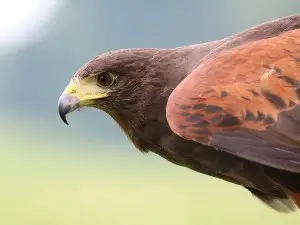
Even birds like hawks must settle down somewhere they call home. But exactly where do hawks nest?
Hawks, in both urban areas and the wild, nest in secluded areas close to their prey. In urban areas, they nest on window ledges, billboard platforms and towering roofs. In the wild, they nest in tall trees close to grassy fields, lakes, creeks and in cliffs. They need a birds-eye view of everything around them.
With over 200 known species, these birds of prey are feared and loved. Hawks eat reptiles, rodents, mammals, roadkill, and even other birds.
They have no known natural predators but unfortunately, their species have felt the effects of human industrial progress. Because of this many hawk types are on wildlife protection lists.
Whether scooping up prey or migrating they rack up frequent flier miles and at some point, in time they need to call it a day and head home for some shut-eye. But where exactly is home?
Whether you’re a bird watcher, lover or haveyour head in the clouds, this article can help you out, it explores where these creatures nest.
Table of Contents
Where do hawks, nest?
Hawks are medium-sized birds with high metabolic rates. They like to nest in places that are both high up and within reach of food to satisfy their metabolism needs.
In general, in the wild, hawks can be found nesting in high, airy environments with good amounts of flying space. They like tall trees close to grassy fields or lakes, beside creeks and the crannies of cliffs.
For them, having a birds-eye-view is very necessary. The ability to scope out prey and safeguard their territory from invaders is a must. In city areas like as New York and parts of Texas, hawk nests are often found pitched on window ledges, billboard platforms and towering roofs.
They may not mark their territory like dogs and other animals do but hawks are territorial. This is especially true closer to winter, when there is a shortage of prey and when they have young ones in their nests.
Hawks can become highly guarded. They do this to keep out other birds and other hawks who may be on the hunt for food. They also secure against nest poaching predators that may seek to snatch their young one for mid-day lunch.
Nesting in high places offers them lots of benefits and privileges, unfortunately, it can also prove to be difficult too. Hawks have the benefits of seclusion and a great view in high areas and cliffs. But these areas are becoming less accessible and far from their prey. As urbanization occurs tall trees become lumber, grassy fields no more, cliffs become climbing spots, hawks are often evicted and thus need to relocate.
Sure billboards, window ledges and high rooftops are accessible, but they are few and not ideal. Also, as possible nesting spots in the wild become replaced, reptiles and mammals also get with the times and relocate. These issues along with other challenges have resulted in many hawk species becoming endangered.
How do hawks make nests?
Nests are important for birds, they are the one thing that they spend time and effort into creating. A nest needs to be sturdy against wind and movements. It needs to protect their young, while deterring nest egg poachers and it needs to feel comfy enough to be called home.
Hawks knit their nests together from twigs, tall piles of dry sticks, strips of tree bark, fresh vegetation, and dry vegetation. They build this open air home about 6.5 feet high and 3 feet across. They will build the nest over a 4 to 7 day work period.
To us, it may not look impressive, but they aren’t an architectural mess either, as they allow for movement and allow for renovations over time.
Nest building is a two-bird activity for hawks. They are strictly monogamous. Yet they don’t share a nest with their partner and usually don’t share the same tree, talk about needing space. That being said, they both actively engage in building nests together for each to rest.
Do hawks make nests in the same place each year?
Hawks do enjoy their space and are territorial, they are also migrate when the time comes, seeking better hunting grounds and weather conditions when winter sets in. Thus they need more than one nest.
When they travel between destinations it’s not beneficial to lose 4 to 7 days creating new nests every stop along the way. They also can’t carry their home along with them like snails do. So, they make do with communal nesting. A bit like motels or inns along the way.
While migrating they spruce up a nest for temporary rest. They simply spruce up existing nests that they made before. They do also often create entirely new ones.
Throughout their life cycle, they build multiple nests that they frequently nest in but if it is filled or missing they will use another or build one.
Conclusion
Hawks build nests in tall trees, high towering roofs, on billboard signs near airy spaces, close to lakes and creeks where they can find their prey. Unfortunately, hawk nesting spots are becoming less available because of human urbanization.
Hawks come together as monogamous couples to build new nests and spruce up old damaged nests along the way to their migratory, vacation chalet.
If you’re reading this article you may also enjoy these other articles on hawks. Click the link to read the article. What are hawks afraid of, when do hawks lay eggs, where do sparrow hawks nest, where do sparrow hawks live and what do baby hawks eat.

